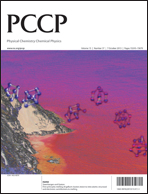Quantification of intramolecular cooperativity in polynuclear spin crossover Fe(ii) complexes by density functional theory calculations†
Abstract
The influence of the spin state of nearest neighbours on the spin transition of a given centre has been modelled with density functional theory methods for the linear oligomeric Fe(II) complexes of


 Please wait while we load your content...
Please wait while we load your content...